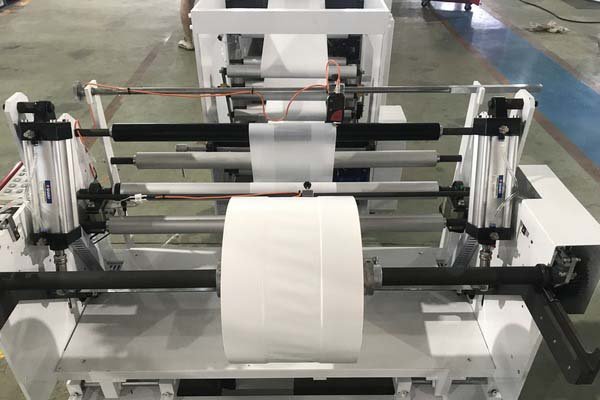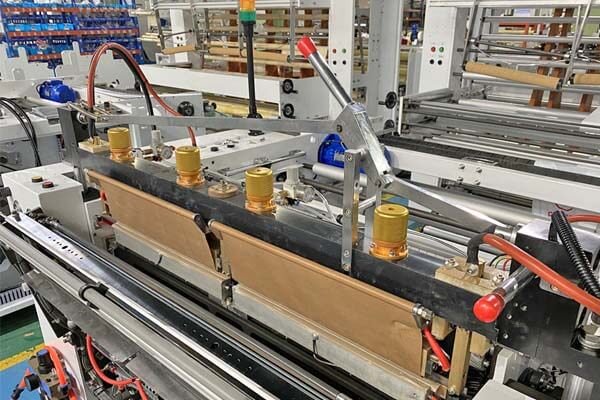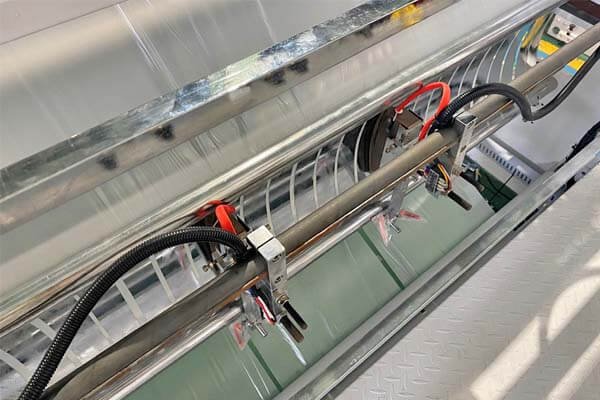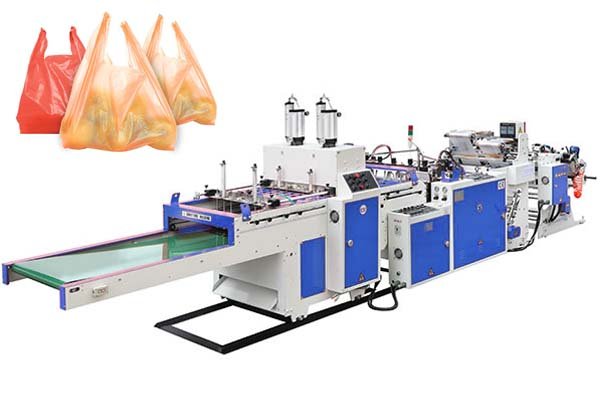
You see plastic bags everywhere, and you might think making them is simple. But you worry that poor quality and slow machines could damage your business reputation. This leads to wasted materials, unhappy customers, and a lot of stress. The solution is using a specialized, high-quality machine1 that makes production easy and reliable.
Yes, producing plastic bags is very straightforward with the right equipment. A dedicated machine automates the entire process. It handles film feeding, sealing, cutting, and stacking. This allows for simple, efficient, and high-volume production of quality bags.
The idea of making a plastic bag seems basic. You take a plastic film, you seal it, and you cut it. But the real work happens inside the machine. Its precision makes all the difference. For example, our machines use a patented "Smart Tension Control2" system. This ensures the plastic film feeds smoothly without any wrinkles. This is very important for creating strong, dependable seals. We also use energy-saving servo motors. They reduce your power consumption by up to 30% and give you precise control over the production speed.
This precision technology directly impacts your final product. The "Smart Tension Control" automatically adapts as the film roll gets smaller. This means the first bag is the same quality as the last. The servo motors provide exact starts and stops. This is essential for making clean cuts and perfectly aligned handles. You can see this on our T-Shirt Bag Making Machines. This level of control ensures every bag meets your quality standards, and it reduces material waste significantly.
How do you manufacture plastic bags?
So, a good machine is the most important part. Now, let's look at the specific steps. How does a large roll of plastic film actually become a finished shopping bag?
The plastic bag manufacturing process3 has four main steps. First, the machine unwinds and feeds the plastic film. Second, it uses heat to seal the sides and bottom. Third, it cuts the film into individual bags. Finally, it stacks the finished bags neatly.
Let's dive deeper into each of these stages. The quality of your final product depends on how well each step is performed. Different types of bags also require small variations in this process.
Step 1: Film Unwinding and Feeding

This is the foundation of the entire process. A large roll of plastic film is mounted onto the machine. The machine then pulls the film into the production line.
- Material Compatibility: Our machines can handle a wide variety of materials. This includes standard LDPE and HDPE films. It also includes modern materials like biodegradable PLA and multi-layer laminates for food packaging.
- Tension is Key: The film must be kept at a consistent tension. If it's too loose, it will wrinkle. If it's too tight, it can stretch or tear. Our "Smart Tension Control" technology automates this, ensuring the film feeds perfectly from the beginning of the roll to the end.
Step 2: Sealing and Gusseting

Once the film is fed, it's time to create the bag's shape. This is done with heat.
- Sealing Types: The most common methods are bottom sealing and side sealing. A heated bar presses the layers of film together, melting them to form a seam. Our Side Sealing Bag Machines, priced between $10,500 and $18,500, are excellent for creating strong seams for various applications. For heavy-duty bags, we use reinforced sealing techniques to ensure they can carry heavy loads without breaking.
- Gusseting: Some bags, like shopping bags, have folds on the side called gussets. These allow the bag to expand and hold more volume. This process happens before the final sealing.
Step 3: Cutting and Punching

After the bag is sealed, it needs to be cut from the continuous roll of film.
- Cutting: A sharp blade cuts each bag to the correct length. The speed and precision are controlled by servo motors to ensure every bag is identical.
- Handle Punching: This is where different bag styles are created. For a T-shirt bag, a hydraulic press punches out the handle shapes. For a patch handle bag, a separate piece of reinforced plastic is heat-sealed onto the bag before the handle hole is cut. Our Patch Handle Bag Making Machines offer an affordable entry point, starting at just $8,500.
Step 4: Stacking and Automation

The final step is to collect the finished bags.
- Simple Stacking: Basic machines will stack the bags on a collection table for manual removal.
- Advanced Automation: More complex machines, like our Wicketer Bread Bag Machine ($69,000–$88,000), have advanced stacking systems. They use a "wicket" system to hold bags in place for easy automated or manual filling later on. All our machines come with PLC control and touchscreen interfaces, so you can easily manage the speed, bag length, and batch count.
To make it clearer, here is a table showing the process for different bags:
| Bag Type | Key Process Steps | Recommended BagMec® Machine |
|---|---|---|
| T-Shirt Bag | Bottom Seal, Gusseting, Handle Punching | T-Shirt Bag Making Machine |
| Courier Bag | Side Seal, Adhesive Strip Application, Flap Folding | Courier Bag Machine |
| Lamination Pouch | Three-Side Seal, Zipper Integration | Lamination Pouch Making Machine |
| Garbage Bag | Bottom Seal, Perforation for Bag-on-Roll | Garbage Bag Machine |
Can you make money selling bags?
Understanding how to make bags is important. But the main question for any business owner is about profit. Is it possible to build a profitable business selling plastic bags?
Yes, you can absolutely make money selling plastic bags. The market is very large. Your success depends on finding a good niche, controlling your costs, and running an efficient operation. A reliable machine is essential for achieving a high return on investment.

Profitability is not just about selling price. It is about the entire operation. Let's explore how you can build a profitable bag-making business with the right partner and strategy.
Find a Profitable Market Niche
The demand for bags is everywhere, but some markets are more profitable than others. You need to choose a focus area.
- Retail & E-commerce: This is a huge market. Stores need T-shirt bags and shopping bags. E-commerce businesses need courier bags. Our high-speed shopping bag machines can produce up to 1,200 bags per hour, allowing you to serve high-volume clients.
- Food Packaging: Food safety is a top priority. This market demands high-quality, hygienic bags like zipper pouches or FFS (Form-Fill-Seal) bags. Our machines for this sector are designed to be FDA-compliant. A German packaging supplier uses our FFS machines and has achieved 99% uptime.
- Industrial & Logistics: These sectors need strong, durable bags. Think heavy-duty bags for construction materials or tear-resistant courier bags. Our Heavy Duty Bag Machine ($12,000–$23,000) is built for this purpose. An Indian logistics giant uses our custom line to make 2,500 courier bags per hour.
- Eco-Friendly Products: Sustainability is a growing trend. There is high demand for bags made from biodegradable materials like PLA. We co-developed machines for a US eco-brand to produce 100% compostable shopping bags. This is a premium market where you can get higher prices.
Calculate Your Return on Investment (ROI)
To understand your potential profit, you need to look at the numbers. Your main costs are the machine, raw materials, electricity, and labor. Your revenue comes from selling the bags. A reliable and efficient machine lowers your costs and increases your production, which directly boosts your profit.
Let's look at a simple example for our T-Shirt Bag Making Machine.
| Item | Cost / Calculation | Notes from BagMec® |
|---|---|---|
| Machine Investment | ~$25,000 USD (Mid-range model) | This is a one-time cost. We offer flexible MOQs of 1 machine. |
| Material Cost (per bag) | ~$0.01 | This depends on film price and thickness. Our machines minimize waste. |
| Labor & Electricity (per bag) | ~$0.005 | Our energy-saving servo motors reduce power bills by up to 30%. |
| Total Cost Per Bag | ~$0.015 | This is your production cost. |
| Average Sale Price Per Bag | ~$0.03 | This is a conservative market estimate. |
| Profit Per Bag | $0.015 | |
| Production Per Day | 800 bags/hour x 8 hours = 6,400 bags | Our machines are built for continuous operation. |
| Profit Per Day | 6,400 bags x $0.015 = $96 | |
| Time to Recoup Investment | $25,000 / $96 ≈ 260 working days | You can pay for your machine in about one year. |
Disclaimer: This is a simplified example. Your actual results will vary based on local material costs, labor, and market prices.
How We Help Maximize Your Profit
Our goal is not just to sell you a machine. Our goal is to help your business succeed. We do this by building machines that are an asset, not an expense.
- Durability and Uptime: Our machines undergo a 72-hour continuous stress test before shipment. We use high-carbon steel components to ensure durability. This means less downtime and more production time for you.
- Efficiency: Features like "Smart Tension Control" not only improve quality but also reduce material waste. Our German client reduced their waste by 18%. That is a direct saving that goes straight to your profit.
- Global Support: We offer a 45-day standard delivery and optional on-site installation and training. Our IoT-enabled machines allow for remote diagnostics, so we can help you solve problems quickly without waiting for a technician.
Conclusion:
In short, producing plastic bags is not difficult when you have a reliable machine. The manufacturing process is straightforward, and it can be a very profitable business. Success comes from choosing the right market and using efficient equipment to keep your quality high and costs low.
-
Discover the advantages of investing in high-quality machines for reliable and efficient plastic bag production. ↩
-
Explore how Smart Tension Control enhances production efficiency and bag quality, ensuring consistent results in manufacturing. ↩
-
Understanding the plastic bag manufacturing process can help you optimize production and improve product quality. ↩






